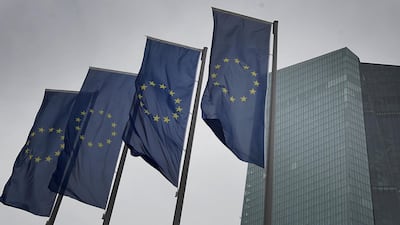Sweden won’t support a €500 billion (Dh2 trillion / $545bn) European Union recovery plan as it was proposed by France and Germany last week but signalled a willingness to discuss a way forward with the bloc’s other members.
Swedish Finance Minister Magdalena Andersson said on Tuesday that her country supports a united response by the EU, but would not back the proposal from Berlin and Paris that would see the bloc tap the bond market for an unprecedented amount of money and distribute that as grants to countries that have suffered economically from the global pandemic.
“We also will support some kind of recovery fund but we will have to discuss exactly how it will look like and from our perspective we think it has to be realistic both when it comes to size but also the conditions,” Ms Andersson said in an interview with Bloomberg TV.
Ms Andersson’s comments come just a day before the European Commission, the EU’s executive arm, unveils its proposal for a recovery package. Her remarks highlight the difficult negotiations the EU’s 27 governments will have over the coming weeks. Some of Sweden’s fiscally conservative allies in recent days have already shown an openness to compromise that may lay the groundwork for an eventual accord.
The commission’s proposal will form the basis for discussions between EU governments, though dividing lines have already been drawn. France and Germany want the fund to make grants to countries and sectors most in need, while also saying that their plan wouldn’t lead to the mutualisation of debt. Austria, Denmark, the Netherlands and Sweden – dubbed the 'frugal four' by media – released their own blueprint over the weekend that would offer loans to countries rather than grants, and would expire after two years.
While EU leaders have agreed on the need for a fund to assist with the recovery, disagreements include its size, whether allocated money would need to be repaid and any conditions tied to the disbursements. While they’ve broadly accepted that some of the money will come from jointly-issued EU debt, how much the bloc will raise remains in dispute.
France and Germany threw their weight behind a plan to allow the commission to issue €500bn of bonds, a significant shift for German Chancellor Angela Merkel who has previously resisted French calls to shoulder more of the burden of the European recovery. The proposal would require approval by all 27 EU countries and the European Parliament.
Despite their scepticism, at least some of the four countries most averse to the Franco-German plan have already softened their positions, signaling a compromise may be in the offing.
Still, leaders in the euro area need to make its widely-touted recovery fund a reality to revive the fortunes of its battered currency.
“The euro’s road to recovery will likely be bumpy as markets assess the scope for the commission to come up with a plan acceptable to all member-states,” Gaétan Peroux, a strategist at UBS Global Wealth Management said in a client note. “Continuing signs of a global and European recovery should eventually open the window to euro-dollar levels above $1.10.”
The lack of region-wide fiscal framework has long been seen as a thorn in the ambitions of EU leaders to make the euro a stronger rival to the US dollar. The currency weakened to its lowest level in three years in March, when Europe became the epicentre for the coronavirus, with the bloc’s most-indebted nations, including Italy and Spain, suffering severe outbreaks.
That same month, five-year Italian credit default swaps – a gauge of EU breakup risk – spiked to the highest since 2013, spurred by worries of a another sovereign debt crisis in the bloc. That measure fell to the lowest level in over a month after the Franco-German proposal.
Bearishness on the euro was the strongest since 2018, according to Citigroup’s FX Pain Index for the currency, an indicator of active trader positions. It’s a sign to some analysts that a so-called short squeeze is looming.

